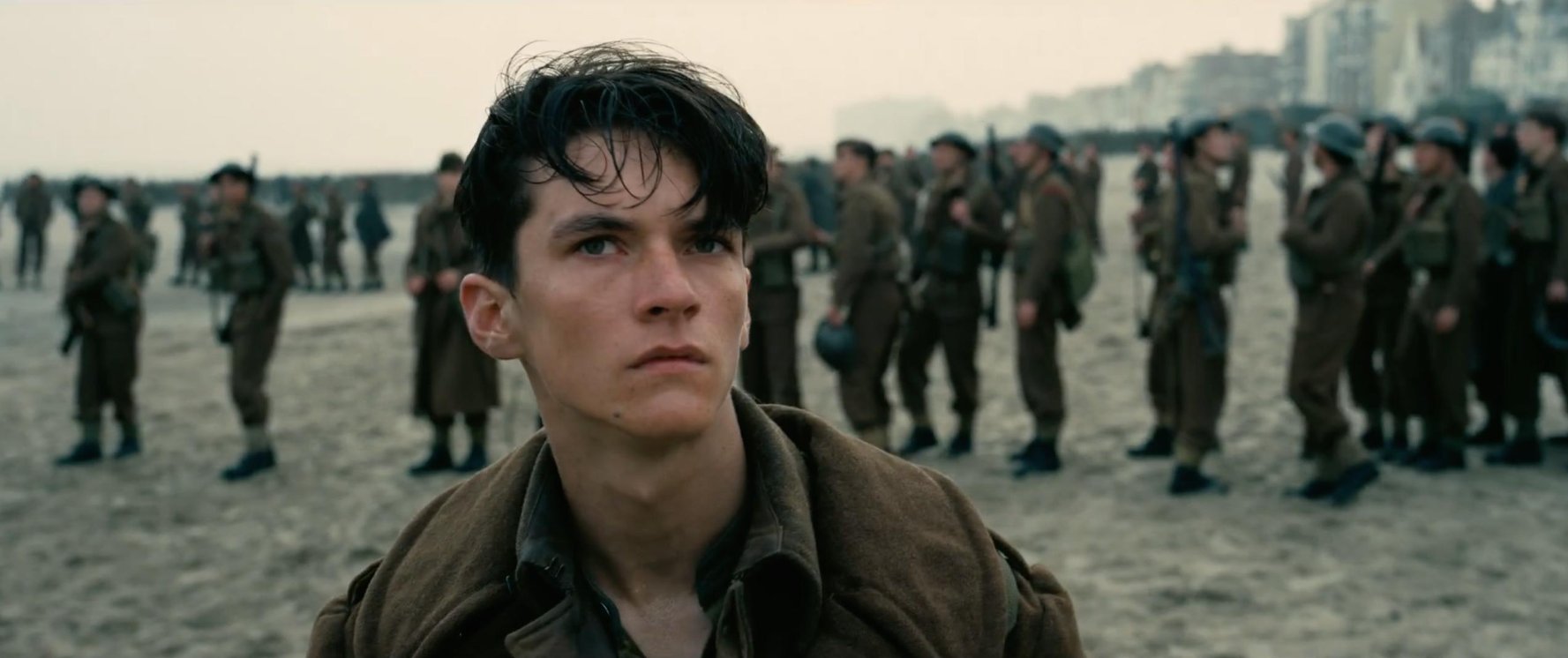Five young men roam the empty, eerily quiet streets of Dunkirk, catching flyers slowing falling from the sky that read “We surround you.” One young man carefully reaches through the opened window of an empty house for a half-smoked cigarette abandoned in an ashtray. Bullets suddenly ricochet through the alley and the group of boys scatters into disarray. We follow one as he sprints to safety, clambering over a wall and stumbling into the fire of his own men. So begins Dunkirk: a minimalist, stripped down World War II film that is simultaneously an expansive, gorgeous visual experience.
Over a year before America entered the war, the evacuation of Dunkirk in 1940 remains a momentous time in British history. In the film, 400,000 English and French troops are trapped by the opposing army and the stormy yet beautiful sea as Hans Zimmer’s tense, abstract score slowly builds.
Nolan’s Dunkirk is no traditional war movie. Viewers do not reside in a world of constant firefights or bombings. Instead, Dunkirk is a tense struggle for survival — the chaos of drowning in the belly of a sinking ship, inhuman screams as spilled oil in the ocean catches fire and burns those who escaped drowning, and a downed Spitfire careening toward the water, hurtling through space to an untimely end. If you’re looking for comic relief or even for a moment to catch your breath, this is not the film for you.
Despite lacking the futuristic narrative of Nolan’s past films, Dunkirk is still clearly a Nolan film. Although WWII took place 80 years ago, viewers are still viscerally in the moment. His use of IMAX cameras to film Dunkirk gives people a startling close view of the action and the soldiers. A small swirl of wet sand slowly trickling down a character’s face and smatterings of freckles across another’s nose and cheeks are clearly visible.
The cinematography is exquisite. Shots of the RAF’s Spitfires diving and twirling through the air are almost overwhelming in IMAX. The stressfulness of their struggle against the enemy is only softened by the shots’ juxtaposition against a stunningly blue sea and sky and the blurry horizon in between. Wide shots of the beach and the hundreds of soldiers scrambling across it make them appear more like ants than people. A last shot of Tom Hardy’s Spitfire pilot hurtling down through the air against the backdrop of a golden sunset is just short of divine.
Nolan has long been fascinated with the complexity of time and space and has twisted their relationship to make navigating his films a more complicated experience. In Dunkirk, Nolan has again warped time and space to subvert the stereotypes and dullness of a linear plotline. Instead he splits the film into three perspectives: The Mole, which covers the course of one week; The Sea, which occurs in one day; and The Air, which stretches out one tense hour endlessly. Viewers are left cutting between the three harrowing experiences, and they do not seemingly fit together until the end of the film, seamlessly integrating each storyline with the others.
The film’s lack of character development and therefore, lack of emotional connection to its characters enables it to avoid the stereotypical tropes of many war movies. Viewers are not introduced to the man with the creased photo of his girlfriend from back home, the skinny, gun-shy kid from Middle America, or the tattooed, tough guy. Instead, Dunkirk is a realistic look at the chaotic scramble to survive. Part of the horror of war is that no one can stop and get to know everybody.
Those who play these stripped down characters include Fionn Whitehead, a relative newcomer to the silver screen before Dunkirk, but handpicked by Nolan to play the film’s central character, Tommy. Tommy is no ubermensch hero, but a projection of the fear, the pain and the desperation that all the men stranded on that beach and fighting in that war experienced. Whitehead barely has any dialogue throughout the film but his very expressive face and slim, gawkish frame give him a naked vulnerability that does not need to be expressed in words.
Singer Harry Styles is impressive in his acting debut. The juxtaposition in Whitehead and Styles’s characters provides an effective dual-look at their fights to survive. Styles plays a hardened, suspicious character, willing to let others take the bullet. In contrast, Whitehead’s Tommy still seems to possess some sliver of innocence, befriending a French soldier he is unwilling to leave behind.
Mark Rylance gives another compelling performance, here portraying a civilian boat captain, determined to make it to Dunkirk for the evacuation. Rylance is completely consumed by his character, giving a particularly emotional scene as he races to a downed Spitfire even though there is no evidence that the pilot survived. Kenneth Branagh’s Navy captain is calm, practical, maybe even a little icy. However, the sight of the hundreds of civilian ships moves him (and us) to tears. His last crisp salute from the top of the dock at Dunkirk after he decides to stay behind for the French troops is particularly poignant.
Both Cillian Murphy and Tom Hardy, long-time Nolan collaborators, are featured in the film as well. Murphy gives a disturbing performance as a shell-shocked soldier, desperate not to go back to Dunkirk. Hardy is close to the only definable hero in the film, playing a Spitfire pilot, unabashedly using his limited fuel to save troops trying to escape across the Channel.
Nolan has again collaborated with Hans Zimmer for the score of Dunkirk. Zimmer uses a ticking clock as the backbone of his music for the film, adding to the sense that these men are in a race to survive. It is perhaps one of Zimmer’s more abstract scores, and it effectively ramps up the tension throughout the film. The last few minutes of music are a beautiful, soaring addition to the finale of the movie, but it is even more emotional and recognizable when the clock and the music finally stop.
WWII has long been made into movies. In some ways, it was one of the last wars with moral clarity in regards to a common enemy. However, Nolan chooses not to focus on the two opposing sides and instead reveals an indistinguishable moral compass among our own Allies. Dunkirk is no glorified war film because the men viewers see on screen are not all heros. There is an astonishing disregard for human life, as in all war; however, it is disconcerting to hear Branagh’s Navy captain ask an Army captain how many more sick he is going to evacuate because 7 healthy men could fit in the place of a stretcher.
Nolan’s work is not only visually stunning but also poignant. Shots of a man slowly shedding his uniform and stepping into the stormy ocean, of three young men falling asleep with the water gently lapping up onto them, and a blind man gently touching Whitehead’s face pack more of an emotional punch than initially expected. Despite a lack of character development, the film and its characters are able to clearly portray emotional vulnerability.
In the second to last scene, viewers are left with Hardy’s burning plane, which would have made a brilliantly beautiful and sad end to an unbearably tense war movie. Rather like Cobb’s spinning totem at the end of Inception, the burning plane would have left audiences with an abstract ending, free to draw any number of conclusions. Instead, for the last scene, Nolan does one better, shifting back to Whitehead, closing in on his face, neither hopeful nor defeated, eyes flickering briefly upward before cutting to black.





